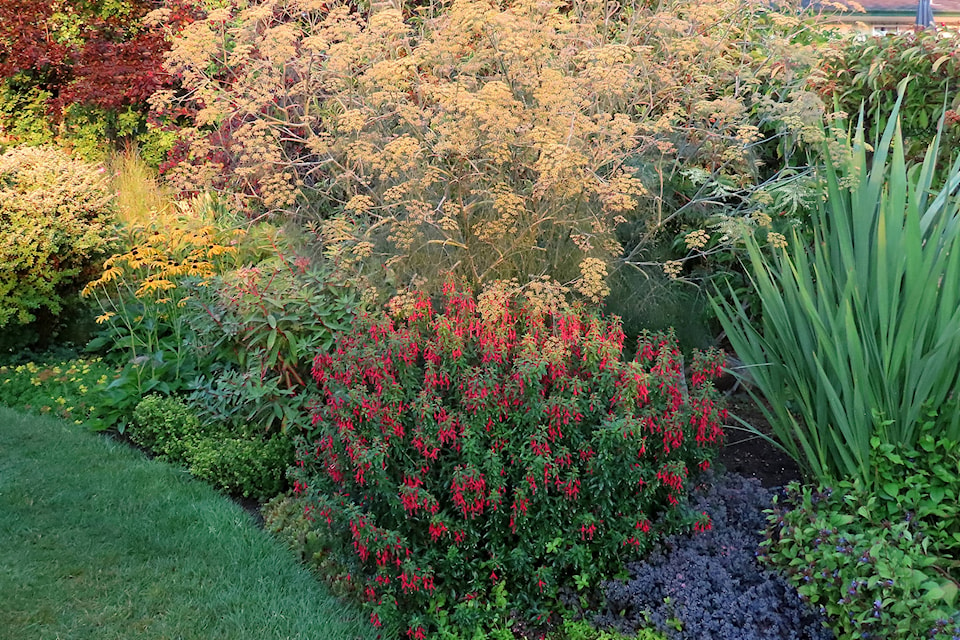This has certainly been a stressful summer for plants and gardeners alike; never before have I recorded a temperature high over 40C in our garden.
But on a recent walkabout the garden early one morning, a few plants grabbed my eye. They looked good in spite of the heat. In fact, they looked stellar, as if they were basking in a summer of normal temperatures.
Naturally, there was the late summer floral performer, black-eyed Susan…Rudbeckia fulgida ‘Goldsturm’. Small wonder it received Perennial Plant of the Year distinction in 1999. The bouquets of sunshine-yellow flowers brighten the day without increasing the heat.
‘Goldsturm’ has grown into a nice-sized clump from the two plants I grew from seed (there were three seedlings originally, but a neighbourhood cat dug up one of them the first night they were transplanted). Well known for its drought tolerance, if not for its cat resistance, ‘Goldsturm’ has definitely proven its hardiness in this summer-like-no-other.
Just behind the black-eyed Susans is a mature bronze fennel, Foeniculum vulgare ‘Purpureum’. At six feet…taller when in full flower…it commands a presence in this bed in spite of its airy leaf formation. The dark colour is a perfect backdrop for the yellow ‘Goldsturm’ flowers. And it is not affected in the least by the hot, dry conditions.
Another late summer bloomer just now revving up to break into flower is the clump of tall bugbane. Some may know it as black snakeroot or Cimicifuga racemosa ‘Atropurpurea’. Thanks to DNA testing, scientists have determined this plant was grouped in the wrong plant genus. It is now known as Actea racemosa Atropurpurea group.
Whatever name you want to call this plant, its flower stalks are structurally impressive in spite of the heat. But I must admit Actea does require regular watering or it will suffer some leaf scorching.
Coneflowers - Echinacea purpurea in our garden, are also doing reasonably well, although some of the flower petals were showing some scorching along their edges. Caused by too much sun or too little water, but very likely a combination of both. I give them a pass, however, because I adore any plant with ray-like flowers.
I really have to add our Hydrangea paniculata ‘Kyushu’ to the list because, in spite of being moved to another part of the garden and reduced to almost half its original size, it has settled in and is now in flower. Not just one or two blossoms, but absolutely covered in gorgeous white panicles. Yes, it has been receiving water regularly because of being relocated, but honestly, to produce flowers after rough treatment and in such tough heat conditions, it deserves an Award of Garden Merit in my humble opinion. Absolutely a thing of beauty.
Another shrub worth mentioning is a little-known one called Indigofera heterantha, Himalayan indigo. This deciduous plant is in the pea family - a valuable garden addition for the nitrogen its roots fix in the soil. It is almost as airy looking as the bronze fennel with its open branches stretching as much as 7 feet and covered in small, green, mimosa-like leaves.
Racemes of dark pink flowers appear in mid-summer through August. It is not fussy about soil conditions and drought tolerance but it does appreciate a bit of afternoon shade on a hot afternoon.
Last, but not least on this list is Fuchsia magellanica - a hardy fuchsia. It is sitting where it gets six hours of sun, or more and hot afternoon sun to boot. This small sub-shrub emanates good health with bright green leaves and masses of minute, dangling, red flowers that last for weeks.
It is nice to see there are a few cheery plants that are surviving the heat - even if the gardener is not.
